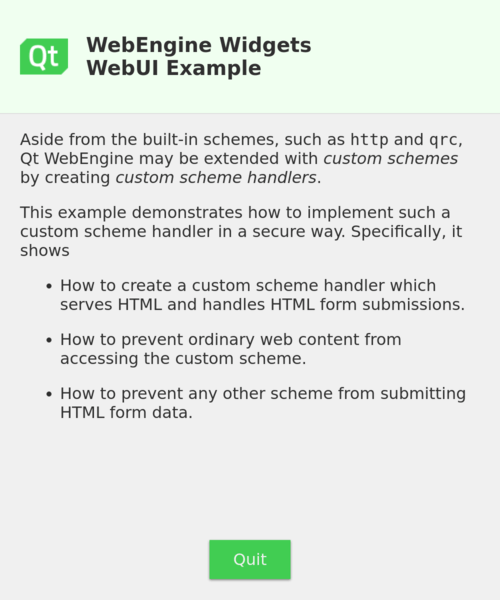在自定义方案上显示 HTML。

WebUI 演示如何以安全方式实现自定义方案。
Aside from the built-in URL schemes, such as
http
and
qrc
, Qt WebEngine may be extended with
custom schemes
by creating
custom scheme handlers
. This example shows:
要运行范例从 Qt Creator ,打开 欢迎 模式,然后选择范例从 范例 。更多信息,拜访 构建和运行范例 .
The example program consists of a single
QWebEngineView
showing a simple HTML page loaded from the URL
webui:about
, over our custom scheme. Pressing the button at the bottom of the page will trigger an HTML form submission via POST to the same URL, at which point our custom scheme handler will cause the application to exit.
The program is divided into two parts, the
main
function for setting everything up, and the
WebUiHandler
class for implementing our custom scheme handler. The
main
function is quite short:
int main(int argc, char *argv[]) { QCoreApplication::setOrganizationName("QtExamples"); WebUiHandler::registerUrlScheme(); QApplication app(argc, argv); QWebEngineProfile profile; WebUiHandler handler; profile.installUrlSchemeHandler(WebUiHandler::schemeName, &handler); QWebEnginePage page(&profile); QWebEngineView view; view.setPage(&page); page.load(WebUiHandler::aboutUrl); view.setContextMenuPolicy(Qt::NoContextMenu); view.resize(500, 600); view.show(); return app.exec(); }
Aside from the relatively standard setup of widgets, two points are noteworthy. First, we call the static method
WebUiHandler::registerUrlScheme()
to register our custom scheme with the web engine. Second, we create and install our custom scheme handler
WebUiHandler
使用
installUrlSchemeHandler()
. The following sections describe these aspects in more detail.
As custom schemes are integrated directly into the web engine, they do not necessarily need to follow the standard security rules which apply to ordinary web content. Depending on the chosen configuration, content served over a custom scheme may be given access to local resources, be set to ignore Content-Security-Policy rules, or conversely, be denied access to any other content entirely.
In order to take advantage of these possibilities, the custom scheme must first be registered. This means creating and configuring a
QWebEngineUrlScheme
object and then handing it over to
QWebEngineUrlScheme::registerScheme
(). The example program does exactly this in the static method
WebUiHandler::registerUrlScheme()
:
void WebUiHandler::registerUrlScheme() { QWebEngineUrlScheme webUiScheme(schemeName); webUiScheme.setFlags(QWebEngineUrlScheme::SecureScheme | QWebEngineUrlScheme::LocalScheme | QWebEngineUrlScheme::LocalAccessAllowed); QWebEngineUrlScheme::registerScheme(webUiScheme); }
A custom scheme needs a name, which can be set by passing it to the constructor of
QWebEngineUrlScheme
or by calling
QWebEngineUrlScheme::setName
. In the above, the name
webui
is set through the constructor. Additionally, we activate the flags
SecureScheme
,
LocalScheme
and
LocalAccessAllowed
. Since our custom scheme handler will not deliver resources received from insecure network connections, we can safely mark it as a
SecureScheme
。
LocalScheme
flag prevents content from non-local schemes (such as
http
) from interacting with our custom scheme. Without this flag it would be possible, for example, to embed the
webui:about
page in an
<iframe>
element on a remotely loaded HTML page, perhaps to attempt a phishing attack. We also need the
LocalAccessAllowed
flag without which we would not be able to access the
webui
scheme from our
webui:about
页面。
Earlier we saw that the call to
WebUiHandler::registerUrlScheme()
is made already at the top of the
main
function. This is so because custom schemes need to be registered as early as possible so that that they can be passed to all subprocesses. Specifically, custom schemes need to be registered before any other Qt WebEngine classes are instantiated by the application.
A custom scheme handler is, broadly speaking, similar to a web application served over HTTP. However, because custom schemes are integrated directly into the web engine, they have the advantage in terms of efficiency: there's no need for generating and parsing HTTP messages or for transferring data over sockets.
Implementing a handler means creating a subclass of
QWebEngineUrlSchemeHandler
, which is just what is done by the
WebUiHandler
class of the example program:
class WebUiHandler : public QWebEngineUrlSchemeHandler { Q_OBJECT public: explicit WebUiHandler(QObject *parent = nullptr); void requestStarted(QWebEngineUrlRequestJob *job) override; static void registerUrlScheme(); const static QByteArray schemeName; const static QUrl aboutUrl; };
For each request to a
webui
URL, the
WebUiHandler::requestStarted()
method will be called:
void WebUiHandler::requestStarted(QWebEngineUrlRequestJob *job) { static const QUrl webUiOrigin(QStringLiteral(SCHEMENAME ":")); static const QByteArray GET(QByteArrayLiteral("GET")); static const QByteArray POST(QByteArrayLiteral("POST")); QByteArray method = job->requestMethod(); QUrl url = job->requestUrl(); QUrl initiator = job->initiator(); if (method == GET && url == aboutUrl) { QFile *file = new QFile(QStringLiteral(":/about.html"), job); file->open(QIODevice::ReadOnly); job->reply(QByteArrayLiteral("text/html"), file); } else if (method == POST && url == aboutUrl && initiator == webUiOrigin) { job->fail(QWebEngineUrlRequestJob::RequestAborted); QApplication::exit(); } else { job->fail(QWebEngineUrlRequestJob::UrlNotFound); } }
QWebEngineUrlRequestJob
对象
job
contains the request's attributes and provides methods for replying to the request with a response. Responses are generated asynchronously by reading them from the
QIODevice
that the application passes to
reply()
.
警告:
requestStarted()
method is not called from the main thread, but from the web engine's IO thread. Care must be taken to synchronize access to any resources on the main thread.
Aside from the usual fare of
requestMethod
and
requestUrl
, there is also the
initiator
, holding the origin of the content which initiated the request. An empty
initiator
means the request was initiated directly by the application (via
QWebEnginePage::setUrl
(), for example). The special value
"null"
corresponds to an opaque origin (a sandboxed
<iframe>
element, for example). Otherwise, the
initiator
will contain the URL scheme, hostname, and port of the content which initiated the request.
在此范例中,
initiator
is used to ensure that
POST
requests to
webui:about
will only trigger the application's exit if they originate from the
webui
scheme. This prevents content loaded over other schemes from triggering the application's exit.